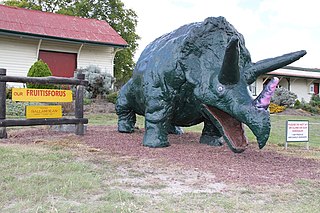
St Hilda's School is an independent, Anglican, day and boarding school for girls, located in Southport, a central suburb of the Gold Coast, Queensland, Australia.

Beerburrum is a small town and coastal locality in the Sunshine Coast Region, Queensland, Australia. In the 2016 census, Beerburrum had a population of 763 people.

Kaimkillenbun is a rural town and locality in the Western Downs Region, Queensland, Australia. In the 2016 census, the locality of Kaimkillenbun had a population of 293 people.

Coominya is a rural town and locality in the Somerset Region in South East Queensland, Australia. The town is located 83 kilometres (52 mi) west of the state capital, Brisbane and approximately 2 kilometres (1.2 mi) from Wivenhoe Dam. In the 2016 census, Coominya had a population of 1,200 people.

Applethorpe is a rural town and locality in the Southern Downs Region, Queensland, Australia. It is on Queensland's border with New South Wales. It is well known for the production of apples. It often records the lowest temperatures in Queensland.

Amiens is a rural locality in the Southern Downs Region, Queensland, Australia. In the 2016 census, Amiens had a population of 293 people.

Ballandean is a rural town and locality in the Southern Downs Region, Queensland, Australia. In the 2016 census, the locality of Ballandean had a population of 338 people.

Dalveen is a town and a locality in the Southern Downs Region, Queensland, Australia. It borders New South Wales. In the 2016 census, Dalveen had a population of 335 people.

St Denys Anglican Church is a heritage-listed church at 17 Trevethan Lane, Amiens, Southern Downs Region, Queensland, Australia. It was built from 1923 to 1923. It is also known as Church of St Denys. It was added to the Queensland Heritage Register on 3 August 2005.

Mount Mort is a rural locality in the City of Ipswich, Queensland, Australia. In the 2016 census, Mount Mort had a population of 91 people.
Kogan is a rural town and locality in the Western Downs Region, Queensland, Australia. In the 2016 census the locality of Kogan had a population of 190 people.

Oman Ama is a rural locality in the Goondiwindi Region, Queensland, Australia. In the 2016 census, Oman Ama had a population of 38 people.
Silver Spur is a rural town and locality in the Goondiwindi Region, Queensland, Australia. It is on the border of Queensland and New South Wales. In the 2016 census, Silver Spur had a population of 72 people.
Glen Aplin is a rural locality in the Southern Downs Region, Queensland, Australia. In the 2016 census, Glen Aplin had a population of 503 people.
Pozieres is a rural locality in the Southern Downs Region, Queensland, Australia. In the 2016 census Pozieres had a population of 145 people.

Fleurbaix is a locality in the Southern Downs Region, Queensland, Australia. In the 2021 census, Fleurbaix had a population of 56 people.
Passchendaele is a rural locality in the Southern Downs Region, Queensland, Australia. In the 2016 census, Passchendaele had a population of 30 people.
Sugarloaf is a rural locality in the Southern Downs Region, Queensland, Australia. In the 2016 census, Sugarloaf had a population of 113 people.
Noorindoo is a rural locality in the Maranoa Region, Queensland, Australia. In the 2016 census, Noorindoo had a population of 55 people.
Stanthorpe–Texas–Inglewood Road is a continuous 152.8 kilometres (94.9 mi) road route in the Southern Downs and Goondiwindi regions of Queensland, Australia. It has two official names, Stanthorpe–Texas Road and Inglewood–Texas Road. The entire route is signed as State Route 89. Tourist Drives 5 (Amiens) and 8 and the Shearer’s Way all start in Stanthorpe and run concurrent with this road for part of its length.














